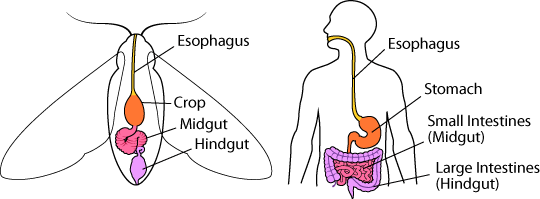How do animals grow?

Many people say “you are what you eat.” There is some truth to this statement. The food that animals eat can be transformed into usable energy for cells or can be used to build new cells, which form tissues like skin and muscle.
How exactly are foods transformed into tissues during growth? The process of growth involves eating food, breaking down food through digestion, absorbing nutrients from food, and building tissue.

Step 1: Eating
To start this process of growth organisms need to eat. Insects like the Manduca must eat a lot in order to multiply in size by 1000 times. Many animals spend the majority of their day eating food.
Step 2: Digestion
While some animals eat their food whole, most animals chew their food to break it down into smaller pieces, this is known as mechanical digestion. These pieces aren’t small enough to fit into cells, so the next step is to chemically digest the molecules in food into even smaller pieces using digestive enzymes and stomach acid. There are specific enzymes that break down the molecules found in food, which include: lipids, carbohydrates, proteins, and nucleic acids.
Step 3: Absorption
Once the lipids, carbohydrates, proteins, and nucleic acids are digested, they can be transformed into usable energy for tissues, or make up the tissues themselves.

For example, the proteins obtained from food are broken down into amino acids, which can be used to construct proteins found in the cells composing muscle tissue, and lipids provide the source for the fatty acids found in the membranes of all cells, which make up tissues.
So how does a Manduca larva increase its size by 1000 times? It takes the lipids, carbohydrates, proteins, and nucleic acids from the foods it eats, and uses them to make more new cells, thereby increasing its body size. This is the same process that is used for growth in all living things, from mosquitos to blue whales.

Bibliographic details:
- Article: How Do Animals Grow?
- Author(s): Dr. Biology
- Publisher: Arizona State University School of Life Sciences Ask A Biologist
- Site name: ASU - Ask A Biologist
- Date published:
- Date accessed:
- Link: https://askabiologist.asu.edu/manduca/how-animals-grow
APA Style
Dr. Biology. (). How Do Animals Grow?. ASU - Ask A Biologist. Retrieved from https://askabiologist.asu.edu/manduca/how-animals-grow
Chicago Manual of Style
Dr. Biology. "How Do Animals Grow?". ASU - Ask A Biologist. . https://askabiologist.asu.edu/manduca/how-animals-grow
Dr. Biology. "How Do Animals Grow?". ASU - Ask A Biologist. . ASU - Ask A Biologist, Web. https://askabiologist.asu.edu/manduca/how-animals-grow
MLA 2017 Style

Manduca caterpillars spend the majority of their day eating.
Be Part of
Ask A Biologist
By volunteering, or simply sending us feedback on the site. Scientists, teachers, writers, illustrators, and translators are all important to the program. If you are interested in helping with the website we have a Volunteers page to get the process started.


